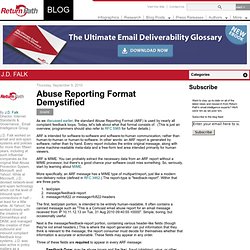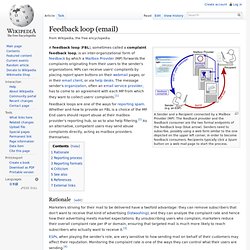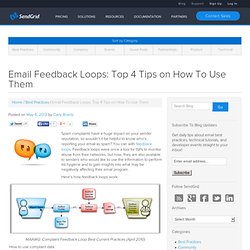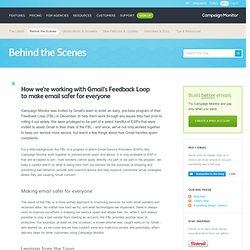

Abuse Reporting Format Demystified. As we discussed earlier, the standard Abuse Reporting Format (ARF) is used by nearly all complaint feedback loops.

Today, let's talk about what that format consists of. (This is just an overview; programmers should also refer to RFC 5965 for further details.) ARF is intended for software-to-software and software-to-human communication, rather than human-to-human or human-to-software. In other words: an ARF report is generated by software, rather than by hand. Every report includes the entire original message, along with some machine-readable meta-data and a free-form text area intended primarily for human viewers. ARF is MIME. More specifically, an ARF message has a MIME type of multipart/report, just like a modern non-delivery notice (defined in RFC 3462.)
Text/plain message/feedback-report message/rfc822 or message/rfc822-headers The first, text/plain portion, is intended to be entirely human-readable. Feedback loop (email) A Sender and a Recipient connected by a Mailbox Provider (MP).

The feedback provider and the feedback consumer are the two formal endpoints of the feedback loop (blue arrow). Senders need to subscribe, possibly using a web form similar to the one depicted on the upper left corner, in order to become feedback consumers. Recipients typically click a Spam button on a web mail page to start the process. A feedback loop (FBL), sometimes called a complaint feedback loop, is an inter-organizational form of feedback by which a Mailbox Provider (MP) forwards the complaints originating from their users to the sender's organizations. MPs can receive users' complaints by placing report spam buttons on their webmail pages, or in their email client, or via help desks. Feedback loops are one of the ways for reporting spam.
As sketched above, the process implies that Spencer, besides being the author (or sender) of the message, is connected to the postmaster responsible for his mail domain. Email Feedback Loops: Top 4 Tips on How To Use Them. Spam complaints have a huge impact on your sender reputation, so wouldn’t it be helpful to know who’s reporting your email as spam?

You can with feedback loops. Feedback loops were once a tool for ISPs to monitor abuse from their networks, but now, they are also available to senders who would like to use the information to perform list hygiene and to gain insights into what may be negatively affecting their email program. What is a Feedback Loop? I thought I would write about what a feedback loop actually is in this blog.

I’ve come across several clients recently that are not aware of how a feedback loop works and how it can be used. I’m hoping this blog will be a useful reference point for those types of explanations. Aside from learning the basics below, I highly recommend signing up for the upcoming webinar, The Gift of Spam Complaints. Some of our client service experts will be discussing feedback loops more thoroughly and will be open for questions. What is it? What Mailbox Providers use FBLs? If you noticed, Gmail is not on this list. How do I get it? What do I need to do? Collect data: The information being sent back to the sender’s feedback loop email address is simply a copy of the message that the complaining member received. List of current Feedback Loops offered at ISPs.
When one of your subscribers clicks “This Is Spam” for an email sent from one of your IPs, this is considered a “complaint.”

If you are having difficulty delivering email to any of the ISPs listed below, a feedback loop (FBL) would benefit you. Each listing below will take you to a page that provides step by step instructions on how to set up your feedback loops. Those companies approved or “whitelisted” for FBLs will be sent a sent a copy of each complaint generated when one of your subscribers reports your email as spam. Monitoring FBLs benefits both bulkmailers and ISPs, in that they help to manage mailing lists as well as providing early warnings of network security issues such as bot infestations, compromised web forms, and other such sources of spam and abuse.
Setting up FBLs correctly at each ISP is a cornerstone of better inbox deliverability. Big Four: Google – does not exist. How we're working with Gmail's Feedback Loop to make email safer for everyone - Campaign Monitor. Campaign Monitor was invited by Gmail's team to enter an early, pre-beta program of their Feedback Loop (FBL) in December, to help them work through any issues they had prior to rolling it out widely.

We were privileged to be part of a select handful of ESPs that were invited to assist Gmail in their trials of the FBL - and since, we've not only worked together to keep our service more secure, but learnt a few things about how Gmail handles spam complaints. For a little background, the FBL is a program in which Email Service Providers (ESPs) like Campaign Monitor work together to prevent email spam and abuse. It is only available to ESP’s that are accepted to join - bulk senders cannot apply directly.
As part of our part in the program, we keep a careful watch on what is being sent from our servers for the purposes of stopping and preventing bad behavior, provide best practice advice and help improve customers' email strategies where they are causing Gmail concern.